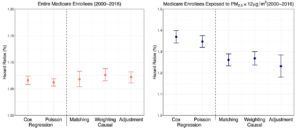There have been numerous studies that support a decrease in the current PM2.5 annual standard of 12 ug/m3. EPA has nonetheless proposed to retain the current standard on the basis that there is too much uncertainty regarding whether those studies provide a basis for concluding that PM2.5 concentrations below the standard cause increased mortality. As I have previously noted, the statutory provision requires that NAAQS be set with an "adequate margin of safety." That would seem to require EPA to resolve such uncertainty in favor of a more stringent standard.
Putting aside EPA's interpretation of the statutory
requirement, evidence continues to roll in. Last week, Science Advances published a study
 which uses causal inference
approaches to conclude that lowering the PM2.5 standard
to 10 ug/m3 would save more than 143,000 lives over ten
years.
which uses causal inference
approaches to conclude that lowering the PM2.5 standard
to 10 ug/m3 would save more than 143,000 lives over ten
years.
Will EPA nonetheless still conclude that the current standard provides an adequate margin of safety? If I were a betting man, I'd certainly put my money on EPA holding firm. I will only add that the idea that EPA will not lower the standard just blows my mind.
Originally published June 29, 2020.
To view Foley Hoag's Law and the Environment Blog please click here
The content of this article is intended to provide a general guide to the subject matter. Specialist advice should be sought about your specific circumstances.

